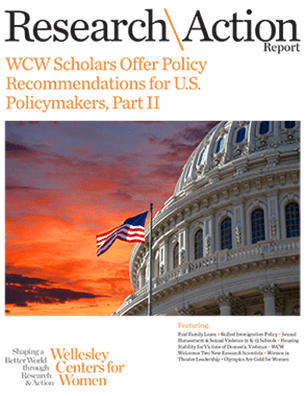Wellesley Centers for Women Welcomes Two New Research Scientists
Research Scientist Erin Johnson is a microeconomist who studies questions in health care such as how physicians respond to financial incentives when making treatment decisions. In addition to measuring impacts of various factors on treatment, her work is interested in the resultant impacts on patient health, which she measures using patient diagnoses and other health indicators. Some of her current work examines how the physician-patient relationship affects treatment.
Erin Johnson, what brings you now to the Wellesley Centers for Women (WCW)?
WCW is a wonderful place where there are vibrant people researching really important topics. And I thought how happy I would be here doing my own research and collaborating with the people who are here, like Senior Research Scientist Sari Kerr and the fantastic group of economists in the College’s Economics Department. I’ll also be teaching in the spring and I’ve heard wonderful things about Wellesley women as students and as research assistants, so I’m looking forward to that as well.
What expertise or partnerships do you bring in terms of research, publications, and networks?
One of my main areas of expertise is in handling large administrative data sets and applying the latest empirical techniques to analyze that data. That allows me to answer questions that people have had a hard time getting a handle on, by discovering new data sets and by using new techniques that allow us to get more out of data sets that have been used in the past. I also have an existing network of colleagues who I collaborate with that allows me to go broader in my techniques and deeper in my analysis than I could do on my own.
I’ve had funding from the National Institutes of Health previously, and I expect to be applying for more to support my projects here. And of course I have previous publications and a research agenda that I’m really excited to develop and push forward and that I hope will support the goals of WCW.
Can you tell us about that?
Much of my research studies how physicians— who are expert decision-makers—make their decisions, and the factors that affect those decisions. Physicians are humans, and therefore are susceptible to biases, like the rest of us. But they’re in a unique position—they treat patients who are relatively uninformed about the care they need, and they’re expected to act in the patient’s best interest. I studythe factors that make a physician deviate from the patient’s best interest, like financial incentives and their own personal comfort and convenience or relationships. So I want to continue to push that forward and I think that being at WCW will change how I approach these questions, because it will make me think more deeply about policy implications, as well as about opportunities to take the research a step further and think about change.
Will you give us an example of your work?

Many of my projects study decision-making in childbirth. There are a number of reasons for that. Decisions on treating patients in childbirth are interesting in their own right; childbirth is the number one inpatient hospital admission in this country; it’s a large portion of health care costs each year—over $12 billion per year; and one thing that’s especially interesting about it is that there’s a lot of variation across geographic areas in this country, in terms of the treatment the patients receive and patient outcomes. The decision to deliver by Cesarean section, or C-section, varies across states, from a low of 22 percent to as high as 41 percent; but you don’t see infants and mothers doing substantially better in those states with either lower or higher C-section rates. So there’s a lot of unexplained variation that we call “physician practice style,” because we don’t know exactly what drives it.
This is really interesting to health economists, because it offers the tantalizing proposition that you could reduce the number of unnecessary C-sections, thereby lowering health care costs without harming any patients. We often think of there being a trade-off between cost and care quality; but this may be an opportunity to lower health care costs without harming any patients, perhaps even improving patient care. And the subject is convenient to study, because there are large data sets which document treatment in childbirth. For example, you can get every birth in the United States going back to the 1960s from the National Center for Health Statistics. And surveys that come with birth certificates from hospitals document treatments and patient outcomes. So there’s really a lot to study there. And it’s nice, also, because you have a well-defined patient population—pregnant women—and a set of treatment options that are observable. But certainly it’s also true that childbirth is a really important event in the life of women and families. So understanding more about how we can optimally treat these patients is really important.
We’re also working with some amazing data from a local academic medical center that includes every woman who delivered a baby there from 2001 to the present, and we know the doctor who delivered her baby and every doctor who provided her prenatal care. We’ve used that for a project studying the impact of physician-patient familiarity on treatment decisions and are pursuing more. In the familiarity study, which is joint work with M. Marit Rehavi, David Chan, and Daniela Carusi, we find that physicians make different decisions for patients they know compared with patients they’re meeting for the first time.
I continue to be interested in health care decisions and provider incentives, and my work on childbirth provides a strong foundation that will allow me to do work on broader women’s health issues in coming years.


